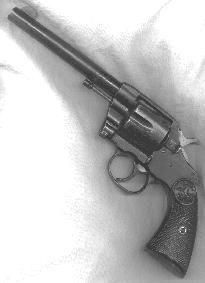


Colt directly developed their line of revolvers from their Single Action Army, better known as the Peacemaker. The Peacemaker was (is) a very durable and simple gun. Its main distinguishing characteristic is a closed frame, which encompasses and holds the revolverís cylinder. Indeed, Coltís first double action revolver, the New Model Double Action, better known as the Lightning in .38 caliber and the Thunderer in .41 caliber, was simply the Peacemakerís frame and barrel mated to a revised "birdís head" grip with a double action trigger mechanism. The main problem with this arrangement was the trigger mechanism's complexity was teamed with weak parts, making simple repair by gunsmiths nearly impossible.
U.S. Revolver, Caliber .38, M1889
This revolver was Coltís first swing-out cylinder design. A spring-powered latch on the left side of the revolverís frame retained the cylinder. The cylinders rotated in a counter-clockwise direction and, as wear occurred, tended to force the cylinder out of exact alignment with the barrel. In spite of this shortcoming, the U.S. Navy purchased 5000 M1889 revolvers between 1889 and 1890.
U.S. Revolver, Caliber .38, M1892
The Army liked the Model 1889, but wanted a small, separate bolt to hold the cylinder in firing position. The change was made and the Army purchased over 11,000 Model 1892s between 1892 and 1893. But the M1892 also suffered from the counter-clockwise cylinder rotation problems of the Model 1889.
U.S. Revolver, Caliber .38, M1894 (Army)
U.S. Revolver, Caliber .38,
M1895 (Navy) (click here for more info.)
U.S. Revolver, Caliber .38, M1896
All these revolvers were externally indistinguishable from the earlier
Model 1892. The main difference lies in the incorporation of a safety
mechanism developed by Frederick Felton into the lockwork. Feltonís
innovation prevented the revolver from being fired while the cylinder
was not fully closed and secured in the weaponís frame. Many Model 1892s
were modified by the addition of Feltonís lock. The Model 1896 was
virtually identical to the Model 1894 and the Model 1895, save a few
minor alterations. The Army and Navy purchased approximately 144,000
Model 1894s, 1895s and 1896s between 1894 and 1900.
| Date Adopted | 1889 | |
|---|---|---|
| Total length: | 11.5 inches (292 mm) | |
| Weight, empty | 2.07 pounds (.94 kg) | |
| Caliber | .38 long Colt | |
| Barrel length: | 6 inches (152 mm) | |
| Muzzle velocity | 785 feet per second (239 meters per second) | |
| Capacity | 6 rounds |
United States Revolver, Caliber .38, M1895 - Same except date of Adoption is 1895
United States Revolver, Caliber .38, M1896 - Same except date of Adoption is 1896